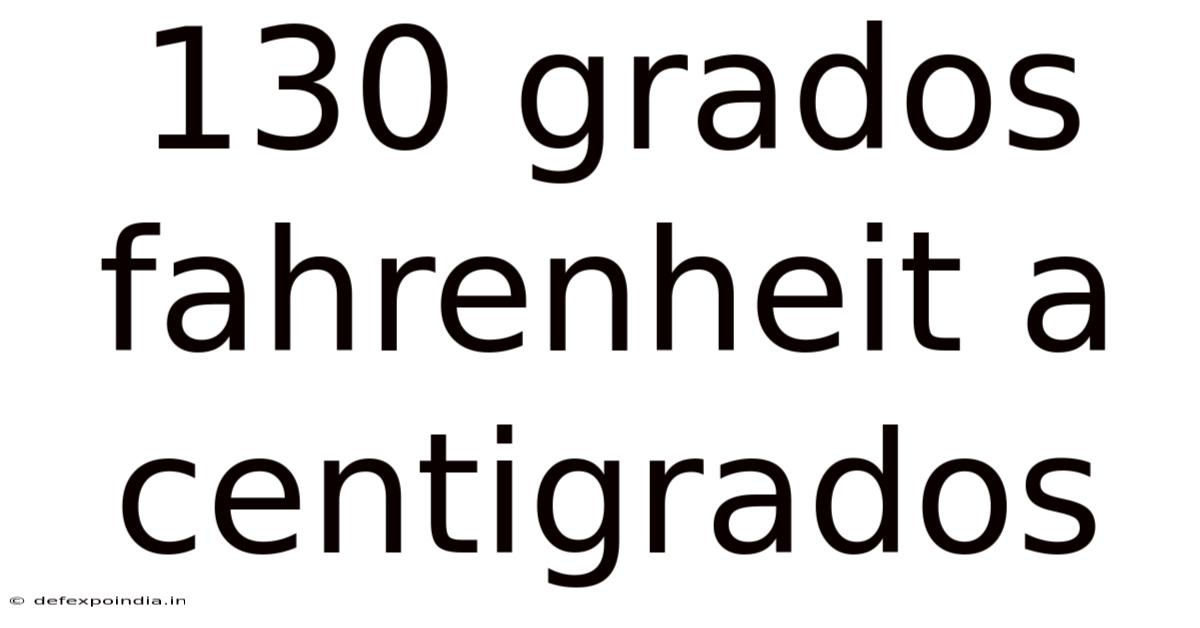130 Grados Fahrenheit A Centigrados
defexpoindia
Sep 20, 2025 · 4 min read

Table of Contents
130 Degrees Fahrenheit to Celsius: A Comprehensive Guide
Converting temperatures between Fahrenheit and Celsius is a common task, particularly for those working in scientific fields, cooking, or simply understanding weather reports from different regions. This article provides a comprehensive guide to converting 130 degrees Fahrenheit (°F) to Celsius (°C), explaining the process, the underlying science, and addressing frequently asked questions. We'll also explore practical applications of this conversion and delve into the history of both temperature scales. By the end, you'll not only know the answer but also understand the why behind the conversion.
Understanding the Fahrenheit and Celsius Scales
Before we dive into the conversion, let's briefly understand the two scales. The Fahrenheit scale, invented by Daniel Gabriel Fahrenheit in the early 18th century, uses the freezing point of water as 32°F and the boiling point as 212°F at standard atmospheric pressure. The Celsius scale, also known as the centigrade scale, uses 0°C for the freezing point of water and 100°C for the boiling point, again at standard atmospheric pressure. The difference lies in the scale's intervals and the reference points used.
Converting 130°F to °C: The Formula and Calculation
The conversion from Fahrenheit to Celsius is governed by a simple linear equation:
°C = (°F - 32) × 5/9
Let's apply this formula to convert 130°F:
°C = (130 - 32) × 5/9
°C = 98 × 5/9
°C = 54.44 (approximately)
Therefore, 130 degrees Fahrenheit is approximately 54.44 degrees Celsius.
A Step-by-Step Guide to Conversion
To make the process clearer, let's break down the conversion into individual steps:
-
Subtract 32: Subtract 32 from the Fahrenheit temperature (130°F - 32°F = 98°F). This step adjusts for the difference in the freezing point of water between the two scales.
-
Multiply by 5/9: Multiply the result from step 1 by 5/9 (98°F × 5/9 ≈ 54.44°C). This adjusts for the different interval sizes between the degree markings on the Fahrenheit and Celsius scales.
-
Result: The final result is the equivalent temperature in Celsius (approximately 54.44°C).
The Science Behind the Conversion: Understanding the Linear Relationship
The linear relationship between Fahrenheit and Celsius stems from the fact that both scales measure temperature based on the expansion and contraction of materials, although they use different reference points and scales. The conversion formula is derived from the relationship between the boiling and freezing points of water in both scales. The equation represents a straight line on a graph with Fahrenheit on one axis and Celsius on the other. This linearity ensures a consistent conversion across the entire temperature range.
Practical Applications of Fahrenheit to Celsius Conversion
The ability to convert between Fahrenheit and Celsius is crucial in various applications:
-
Cooking and Baking: Many recipes are provided in either Fahrenheit or Celsius, depending on the region. Accurate conversion ensures proper cooking temperatures.
-
Scientific Research: Scientific experiments often require precise temperature control, necessitating conversions between units.
-
Weather Forecasting: Understanding weather reports from around the world necessitates converting between Fahrenheit and Celsius, as different countries use different units.
-
Medicine and Healthcare: Maintaining accurate body temperature readings is vital in healthcare, requiring the ability to convert between units for international compatibility.
-
Engineering and Manufacturing: Many industrial processes require precise temperature control, making conversions essential for maintaining optimal conditions.
Frequently Asked Questions (FAQ)
-
Is 54.44°C a high temperature? Yes, 54.44°C is a relatively high temperature, significantly warmer than room temperature. It's hot enough to be uncomfortable for most people.
-
Can I use an online converter? Yes, many online calculators can perform the conversion for you. However, understanding the process is essential to avoid relying solely on technology.
-
What is the significance of the 5/9 factor in the conversion formula? The 5/9 factor accounts for the difference in the magnitude of a degree between the Celsius and Fahrenheit scales. A change of 9°F corresponds to a change of 5°C.
-
Why are there two different temperature scales? Different scales emerged historically, with Fahrenheit being adopted earlier in some parts of the world and Celsius becoming more widely used internationally due to its simplicity and logical relationship to the freezing and boiling points of water.
-
Are there other temperature scales? Yes, other scales exist, including the Kelvin scale, which is used extensively in scientific contexts and has an absolute zero point.
Conclusion: Mastering the Conversion and Beyond
Converting 130 degrees Fahrenheit to Celsius is a straightforward process using a simple formula. Understanding the underlying science behind the conversion, the history of the two scales, and the various practical applications significantly enhances comprehension and problem-solving skills. This knowledge transcends a simple mathematical calculation and provides a deeper understanding of measurement, units, and the world around us. Whether you are a student, a professional, or simply curious, mastering this conversion is a valuable skill with wide-ranging applications. Remember, the key lies not just in knowing the answer (approximately 54.44°C), but in grasping the why behind the conversion process.
Latest Posts
Latest Posts
-
1 5 16 In Millimeters
Sep 20, 2025
-
How Far Is 150 Ft
Sep 20, 2025
-
List The Directories In Linux
Sep 20, 2025
-
100 Meters Converted To Yards
Sep 20, 2025
-
Random Number Generator 6 Digits
Sep 20, 2025
Related Post
Thank you for visiting our website which covers about 130 Grados Fahrenheit A Centigrados . We hope the information provided has been useful to you. Feel free to contact us if you have any questions or need further assistance. See you next time and don't miss to bookmark.